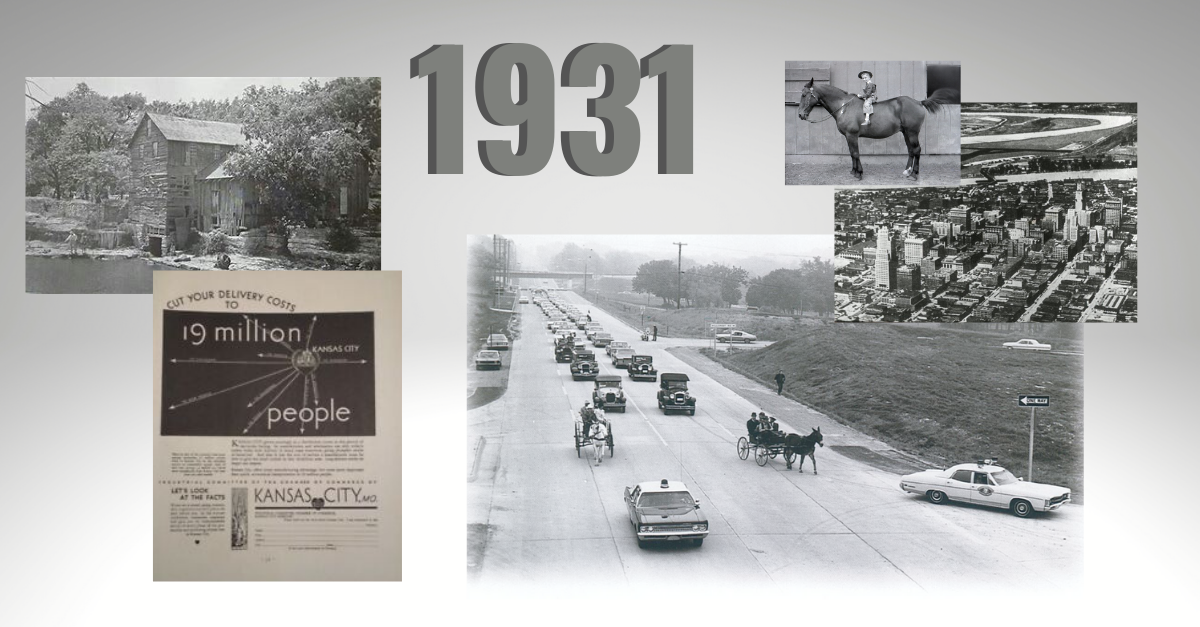In 1931, Hickman Mills had grown to include a bank in a small stone building on Main Street, the Community Church, and the Moore & Moore market housed in an imposing two-story frame building. One former resident recalled that the post office was located in the market and that lodge meetings were held upstairs. The spacious second floor also served as a basketball court, with permanent hoops installed at each end of the hall.
Near the town of Hickman Mills, Kunkel’s Lumber Company and Kemble’s Log Cabin, where barbecue, chicken dinners, beer, and dancing could be enjoyed, attracted customers from throughout the area. Pennington Chicken Dinner Farm, located at 109th and Hillcrest where it had been since 1915, was also a popular attraction. J. B. Brown, whose family ran the restaurant, said that it was among the first of its kind to serve meals family style. “They never advertised. They didn’t have to,” he recalled. “Famous people came from all over to eat there.” The owners of the popular restaurant, which was located near the railroad, also rented out an upstairs room to travelers.
Also in 1931, the newly built Ruskin High School opened to 100 students. At the time, the school had the largest gymnasium in the Kansas City area and later hosted Midwest conference games. A double-page ad in the Grandview-Independence Times dated March 1931 showed support from area businesses for the new school opening. Among the supporters were members of the Consolidated School District Chamber of Commerce. The ad appeared two months before the Chamber was officially incorporated. That same year, the Hickman Mills School Association of Parents held its first meeting to help subsidize items the schools needed but could not afford.
And quietly rising over the hills and valleys, down the curving country roads and among the trees blew the winds of change. In spite of the Depression there was hope for the future.
On May 27, 1931, three Hickman Mills’ businessmen filed an application with the state of Missouri through the circuit court of Jackson County, Missouri for incorporation of the Chamber of Commerce of Consolidated School District No. 1. The new Chamber would serve the consolidated school district south of Kansas City and would be located in Hickman Mills.
This forerunner of today’s South Kansas City Chamber formed a “body politic and corporate” whose purpose was “furthering and promoting the general welfare of the community…to promote, improve, and contribute to the development and extension of the business and social interests of said community in lawful ways…acquire and disseminate, valuable, commercial and economic information and encourage greater interest…of manufacturing and trade industries and attractive homes as factors in the growth and prosperity of the community…etc.”
The signers of this document would all become active members of the newly incorporated Chamber: James I. Keeney, President; R. D. Barry, Secretary-Treasurer; and T. T. Moore. Although it is not clear how long they had been meeting before incorporation, these men obviously had a plan that had been in the works for some time. The Chamber would seem to have been an existing entity even before its official incorporation. Who were the signers of this document?
James I. Keeney was a hog trader and a farmer. He was an employee of the Harry Kennally livestock trading firm and was vice-president of Hog Traders Exchange of Kansas City, with an office in the Livestock Exchange Building in the west bottoms. He was in his 50s when the Chamber was formed and served for only a few years. But he was the first President of the Chamber and later served on the Public Utilities Committee. One of his challenges was to try to get a bus line from Kansas City to Hickman Mills.
Robert D. (Bob) Barry began his career as a cashier at the Hickman Mills Bank and later established a real estate company in the area. His concerns included public utilities, road conditions, and transportation in the community. He helped get city water to Hickman Mills and was active in the Chamber for over 25 years.
Thomas T. (T.T.) Moore did not serve as an officer of the Chamber but was an activist for the community. In 1901, he owned a general store in Hickman Mills and was among the residents who were vital in implementing school consolidation. He was among the founders of the Hickman Mills Bank and served as Bank President and Chairman of the Board for many years. He was interested in getting public utilities to the community and in improving roads. In 1947, he was given a Lifetime Membership in the Hickman Mills Chamber of Commerce.
The early Chamber held dinner meetings at the Community Church. The meal, served by the church ladies, was usually fried chicken with all the accompaniments. Chamber members were hard workers; they deserved a good meal. After spending a long day running their businesses, tending their farms, and volunteering for the fire department, the men of the Chamber (and only men were allowed to be members then) spent hours trying to make things happen around Hickman Mills.
Meeting minutes of 1934 indicate that Chamber members paid dues and elected officers according to Roberts Rules of Order. They lobbied for gas lines, managed a water district, worked for the welfare of the poor in the community, and installed stop signs at the dangerous intersection of Hillcrest and 110th. They worried about illegal dumping, unsanitary outhouses, and ugly road signs.
The next year they worked to get bus service to the township, started a Boy Scout troop, and had a Fireman’s ball to raise money for a fire truck. By 1939 they had seen that Hillcrest Road was repaired, built a water tower, sent Christmas baskets to the needy, worried about septic tank problems, and obtained hospital group insurance for members. They also found a way to stop robberies in the community, by encouraging local farmers to tattoo their poultry and livestock. Remember, this was a very rural community.

